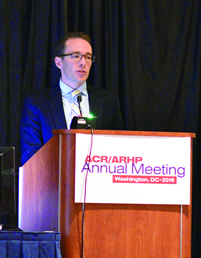Treat-to-target has become almost “the gospel” for clinicians working with adults with rheumatoid arthritis, said one of the presenters during Saturday’s ARHP Clinical Focus Course.

“I think there’s room for further data and evidence, but in general, I think we use this in our patients for the benefits of joint preservation, enhancing work productivity, improving quality of life, and enhancing the probability of remission,” said John M. Davis, MD, MS, Vice Chair of Rheumatology at Mayo Clinic. His presentation during the all-day course focused on the importance of the treat-to-target approach for adults with RA, the recently updated ACR guideline, and as his clinical perspective on managing the disease and comorbidities.
Treat-to-target’s goal is to get patients as quickly and safely as possible to the target of disease remission, although low disease activity may be an acceptable target for certain patients, such as those with severe disease initially, Dr. Davis said. The approach involves measuring a patient’s disease activity using one of several instruments every 1 to 3 months until the target is achieved and then assessing every 3 to 6 months and adjusting therapy if the target is lost.
He also mentioned, however, potential limitations such as patients taking more medications and having more side effects, and there could be increased cost and healthcare burden.
The paradigm shift toward treat-to-target was largely driven by two randomized trials in the early 2000s, the TICORA study in the United Kingdom and the BeSt study in the Netherlands.
“Treating patients to target attained better outcomes than had been seen in usual care,” Dr. Davis said.
The usual care at that time was a so-called pyramid scheme, which involved starting patients on simple drugs, such as an NSAID or hydroxychloroquine, and then typically waiting 6 months to see if they responded.
The 2015 ACR guideline for treating rheumatoid arthritis agrees with the 2012 guideline in recommending the use of treat-to-target but expands on the earlier version in several important ways. For the first time, the guidelines were developed using the GRADE methodology, which involves a more rigorous and transparent evaluation of the evidence. As a result, recommendations for treatment are categorized as strong, meaning that most patients should receive it, or conditional, meaning clinicians and patients should discuss together whether it is an appropriate option.
Dr. Davis discussed strong and conditional recommendations in the new guideline, for when patients either achieve their target or fail to respond to treatment. For patients with inadequate response to methotrexate, there are strong recommendations for other therapies based on studies such as the RACAT trial, whereas there are conditional recommendations for those who fail to respond to biologics.
In cases of treatment failure, barriers to care should be discussed with patients, such as treatment adherence, family and caregiver support, smoking cessation, weight management, depression or other psychosocial issues, and the possibility of a differential diagnosis.
One of the issues that can contribute to depression among patients is patient-provider discordance. Patients often think their disease is less severe (negative discordance) or more severe (positive discordance) than their provider. Both feelings are associated with higher risk of depression.
“Both situations can be problematic, although I think the one that is most challenging for us is the situation in which the patient is struggling and having high levels of pain and disability,” Dr. Davis said.
